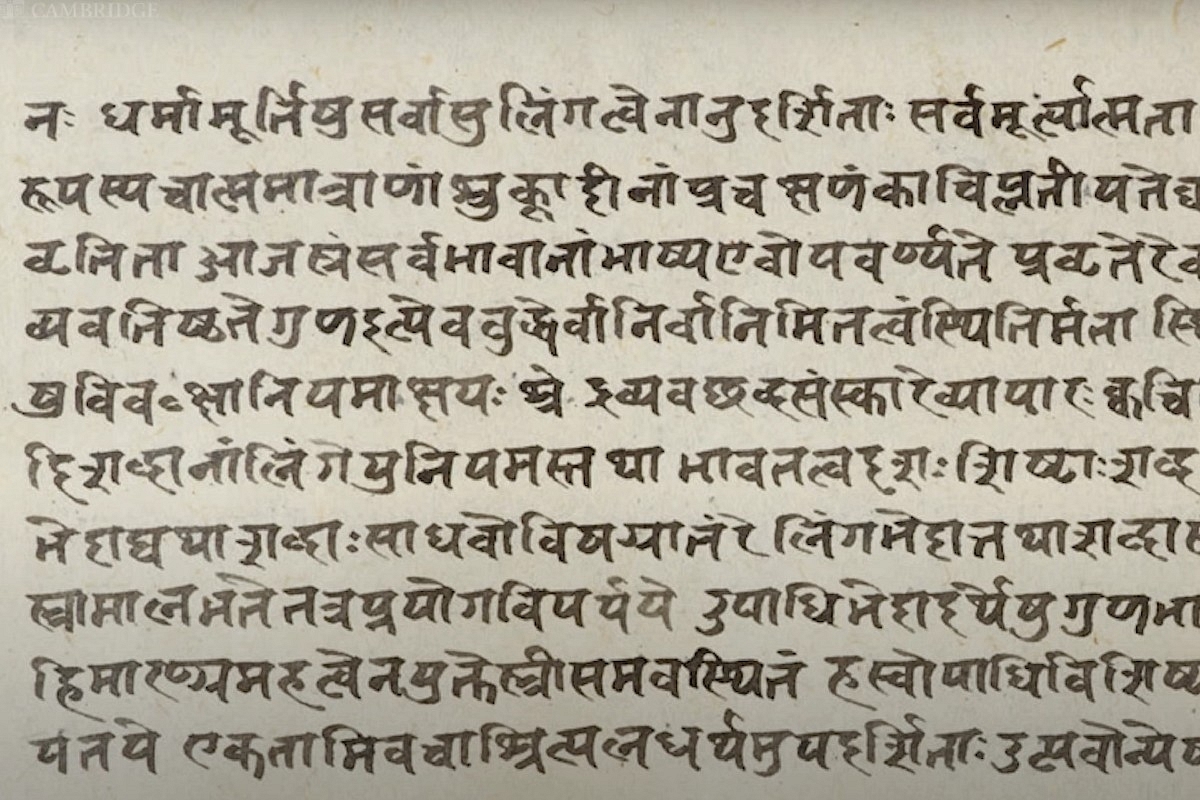World
'World's Greatest Grammatical Puzzle' That Defeated Sanskrit Scholars For 2,500 Years Finally Solved By Indian PhD Student

Representative Image
A grammatical problem which has defeated Sanskrit scholars since the 5th century BC has finally been solved by an Indian PhD student at the University of Cambridge.
Rishi Rajpopat made the breakthrough by decoding a rule taught by “the father of linguistics” Pāṇini, and is now encapsulated in his thesis entitled ‘In Panini, We Trust: Discovering the Algorithm for Rule Conflict Resolution in the Astadhyayi’.
The discovery makes it possible to 'derive' any Sanskrit word – to construct millions of grammatically correct words including ‘mantra’ and ‘guru’ – using Pāṇini’s revered ‘language machine’ which is widely considered to be one of the greatest intellectual achievements in history.
Leading Sanskrit experts have described Rajpopat’s discovery as ‘revolutionary’ and it could now mean that Pāṇini’s grammar can be taught to computers for the first time, the Cambridge University said in a statement.
While researching for his PhD thesis, published on 15th December 2022, Dr Rajpopat decoded a 2,500 year old algorithm which makes it possible, for the first time, to accurately use Pāṇini’s ‘language machine’.
Pāṇini’s system – 4,000 rules detailed in his renowned work, the Aṣṭādhyāyī, which is thought to have been written around 500 BC – is meant to work like a machine.
Feed in the base and suffix of a word and it should turn them into grammatically correct words and sentences through a step-by-step process.
Until now, however, there has been a big problem. Often, two or more of Pāṇini’s rules are simultaneously applicable at the same step leaving scholars to agonise over which one to choose.
Solving so-called 'rule conflicts', which affect millions of Sanskrit words including certain forms of ‘mantra’ and ‘guru’, requires an algorithm.
Pāṇini taught a metarule – termed by Rajpopat ‘1.4.2 vipratiṣedhe paraṁ kāryam’ – to help us decide which rule should be applied in the event of ‘rule conflict’ but for the last 2,500 years, scholars have misinterpreted this metarule meaning that they often ended up with a grammatically incorrect result.
In an attempt to fix this issue, many scholars laboriously developed hundreds of other metarules but Dr Rajpopat shows that these are not just incapable of solving the problem at hand – they all produced too many exceptions – but also completely unnecessary. Rajpopat shows that Pāṇini’s ‘language machine’ is ‘self-sufficient’.
“Pāṇini had an extraordinary mind and he built a machine unrivalled in human history. He didn’t expect us to add new ideas to his rules. The more we fiddle with Pāṇini's grammar, the more it eludes us," Rajpopat said.
Traditionally, scholars have interpreted Pāṇini’s metarule as meaning:
In the event of a conflict between two rules of equal strength, the rule that comes later in the grammar’s serial order wins.
Rajpopat rejects this, arguing instead that Pāṇini meant that between rules applicable to the left and right sides of a word respectively, Pāṇini wanted us to choose the rule applicable to the right side.
Employing this interpretation, Rajpopat found Pāṇini’s language machine produced grammatically correct words with almost no exceptions.
“I had a eureka moment in Cambridge,” recalls Rajpopat.
"After nine months of trying to crack this problem, I was almost ready to quit, I was getting nowhere. So, I closed the books for a month and just enjoyed the summer, swimming, cycling, cooking, praying and meditating. Then, begrudgingly I went back to work, and, within minutes, as I turned the pages, these patterns started emerging, and it all started to make sense,” said the 27-year-old scholar.
“At that moment, I thought to myself, in utter astonishment: For over two millennia, the key to Pāṇini’s grammar was right before everyone's eyes but hidden from everyone's minds!" he said.
“There was a lot more work to do but I’d found the biggest part of the puzzle. Over the next few weeks I was so excited, I couldn’t sleep and would spend hours in the library including in the middle of the night to check what I’d found and solve related problems. That work took another two and half years," Rajpopat added.
A major implication of Dr Rajpopat’s discovery is that now we have the algorithm that runs Pāṇini's grammar, we could potentially teach this grammar to computers, the University said.
"Computer scientists working on Natural Language Processing gave up on rule-based approaches over 50 years ago", said Rajpopat.
“So teaching computers how to combine the speaker’s intention with Pāṇini’s rule-based grammar to produce human speech would be a major milestone in the history of human interaction with machines, as well as in India's intellectual history," he added.
(With inputs from PTI)
Support Swarajya's 50 Ground Reports Project & Sponsor A Story
Every general election Swarajya does a 50 ground reports project.
Aimed only at serious readers and those who appreciate the nuances of political undercurrents, the project provides a sense of India's electoral landscape. As you know, these reports are produced after considerable investment of travel, time and effort on the ground.
This time too we've kicked off the project in style and have covered over 30 constituencies already. If you're someone who appreciates such work and have enjoyed our coverage please consider sponsoring a ground report for just Rs 2999 to Rs 19,999 - it goes a long way in helping us produce more quality reportage.
You can also back this project by becoming a subscriber for as little as Rs 999 - so do click on this links and choose a plan that suits you and back us.
Click below to contribute.
Latest